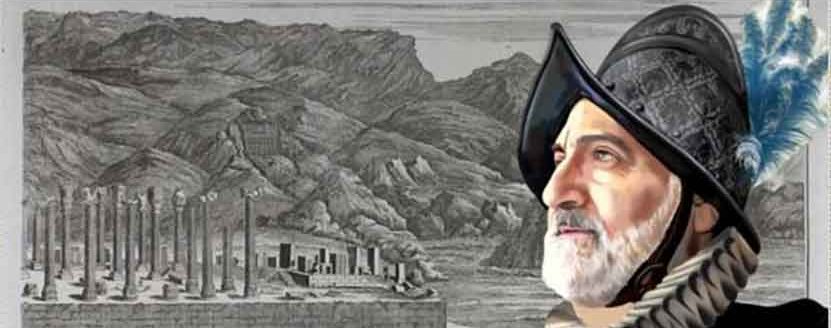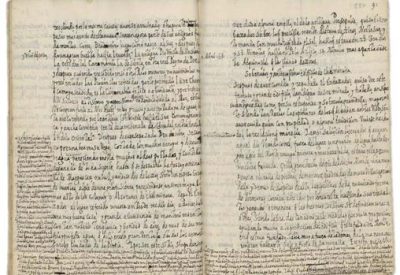Source:ABC
Ambassador García de Silva y Figueroa arrived in Persia in 1618, by order of Philip III, to meet with Sha Abbas the Great of Iran. His journey lasted four years, but he made one of the most important archaeological discoveries in history and became the first European to offer a description of cuneiform writing.
On July 17, 1618, García de Silva y Figueroa was finally before Abbas the Great of Iran. Sent by Philip III as ambassador, it took four years for this Spanish soldier and explorer – born in Zafra, Badajoz – to meet with the Shah to try to establish a military alliance against the Turks. During the trip he circumvented all kinds of dangers and adventures to expose the plans of the King of Spain to the Persian leader, but, once there, he refused to receive him and ordered him to return without an answer. None of that should have mattered to our protagonist, because he had just made one of the most important archaeological discoveries in history: Persepolis, the ancient and disappeared capital of the Persian Empire.
As a result, the ambassador – who appears above according to the illustration of Miguel Zorita – became the first European to offer a description of cuneiform writing, the oldest in the world. And he left for posterity, in addition, one of the most beautiful travel books of the last centuries: “Comments by Don García de Silva y Figueroa from the Embassy to King Abbás of Persia” (Comentarios de don García de Silva y Figueroa de la Embajada al rey Abbás de Persia, Ediciones Orbigo, 2015). A work that, despite its importance and the stir it caused in the intellectual environment of Europe at the beginning of the 17th century, was not translated into Spanish until the 20th century and condemned the ambassador to oblivion.
There have been some historians who have tried to tell his life in past times, but “it is notably little that is known”, said Joaquín María Córdoba in his article “A Spanish Knight in Isfahan” (Un caballero español en Isfahan, CSIC, 2005). “And although we cannot say that we have a detailed portrait, we have certainly managed to recover the profile of a specific being. One that brings us the joyous joy of those who see the image of the loved one whom they were seeking emerge from the mists”, he added afterward.
The ruins of “Chilminara”
When he set sail again in April 1618 to Isfahan in Iran, he turned away from the road to see some ruins he had been told about. In his book, he calls them “Chilminara”. He had an intuition, from what he had read in ancient sources and from what he had been told in Europe, that “this place, without any doubt, must be the ancient Persepolis.” And when he arrived and saw the ruins, he was so perplexed that he did not hesitate a minute of it. The letter sent to his friend by the Marquis of Bedmar, ambassador to Venice, was so rich in details and explanations that the news circulated in the enlightened circles of the main cities of Europe for a time.
“The palace’s architraves which topped the doors above were carved and engraved with many foliages. In some parts there were inscriptions of completely unknown letters”, he pointed out in his mentioned work, where he later specified: “There is an impressive inscription carved in black jasper. The characters are still clear and bright, incredibly free of age deterioration. The letters themselves are neither Chaldean, nor Hebrew, nor Greek, nor Arabic, nor of any people known hitherto. They are triangular, pyramid-shaped, or tiny obelisks, as illustrated in the margin. And they are all identical, except for their position and arrangement. However, the characters resulting from the composition are extraordinarily different».
Figueroa concluded that the cuneiform symbols that adorned those temples were not simple ornaments, but a form of writing. And it is true that António de Gouveia (1602) and Giambattista and Gerolamo Vecchietti (1606) had already recognized them as a type of writing in other found sculptures, but the ambassador will be the first Westerner to describe them. For this reason, the folios that make up Chapter VI of the Fourth Book, in which he carefully proposes and argues this hypothesis, and where he also describes the ruins, are today those that deserve the most attention from researchers.
Death
Figueroa had the bad luck to die at the age of 75, on the high seas, when he was about to arrive in Spain after a decade of travel. It was in February 1624, shortly after leaving Hormuz. The last entry in his journal is from April 28th and referred to to the course of his ship, but the copy kept by the National Library of Spain contains one more statement: “He died on July 22nd at eight o’clock at night by the Evil of Loanda [scurvy], 110 leagues north of the Flores and Cuervo islands. They threw his body into the sea, in a box loaded with stones, which floated calmly around the ship for two days”.
According to this account, the scene must have been tragic for the crew, as if the corpse did not want to leave the ship in which it had been about to fulfil its dream of returning home a decade later. As a legacy, he left a “monument to Spanish and European travel literature”, as Córdoba describes it. A work in which Figueroa describes his journey and his discoveries in incredible detail, ordering his memories in “books” and these, in turn, divided them into chapters with “epigraphs for the convenience of readers”, as he clarified.
The party left Lisbon in 1614 to go to Goa, the capital of Portuguese India. There he remained two long years in detention. After restarting the journey and crossing the Indian Ocean under full sail, he sighted the coast of Arabia on April 8, 1617. Figueroa writes that the heat there was very great and the vision of the earth very sad, of “a red sand color, without appearing in it any green or sign of being inhabited”. They then coasted Oman and crossed the Strait of Hormuz to Persia, where they discovered that the Shah was actually in the Caspian area. In November the ambassador left for Shiraz and there he decided to wait until spring to meet him.
The description
The ambassador focuses, for example, on the gigantic platform covered in thick stone masonry that rests on the Kuh-i Rahmat mountain, which serves as the base for the set of buildings in Persepolis. Also, on the thick marble wall that surrounds it, “of wonderful grandeur and more than two pikes high”. It highlights the gigantic size and perfect size of the stairs of the first palace in which it enters. Once upstairs, he is amazed at the portico, “which is supported by two very large white marble horses, each one larger than a large elephant”. And on the right, it counts 27 huge columns and calculates the height of the building at “seventy feet, without the base”.
He continues his walk through other sets of ruins, which he will later designate as the palaces of Darius, Artajerjes I, Jerjes, Artajerjes III, Palace D and Tripylon, all of them with their reliefs, doors and window frames carved in marble and stone perfectly polished black. The reliefs of these impressed him so much that he sent a painter from his entourage to remove some drawings from life, the first taken “in situ” by a professional, which for centuries were also forgotten in the manuscripts of the National Library.
It was later when, heading towards the side of the mountain, he found a larger temple, which had numerous windows, doors, and columns knocked down in the main courtyard. This area powerfully caught his attention, since it had inscriptions on the architraves and the friezes. He fixed his gaze on one that was engraved with deep grooves and had one of its lines copied “with letters made up of small pyramids and arranged in different ways”. He soon identified them as the writings of the ancient builders.
A city “buried for so many centuries”
At the end of this description, Figueroa reasons his hypothesis that “Chilminara” was Persepolis, for which he resorts both to the classic sources that made reference to it, and to the reports that Fray Antonio de Gouvea had provided him in Spain. And he concluded that this was the capital “buried for so many centuries”. “The last entry is of melancholic and poetic beauty”, Córdoba points out in his article, “when he says that at dusk, the ambassador gathered towards Margascan, a large number of storks flew over his entourage in turn, returning to the nests installed on the legendary columns”.
It is a pity that the achievements of our ambassador – who in his youth studied Law in Salamanca, served in the Flanders Army and was Governor of Badajoz – have taken so long to be recognized. This was attempted by a Parisian publisher named Wicquefort, who published a French translation of an incomplete manuscript 43 years after his death. The work, however, fell into oblivion not long after, amid the avalanche of new publications increasingly complete and full of magnificent engravings. However, the first Spanish edition of the trip and the Figueroa embassy did not arrive in our country until 1903 and 1905. Its manager was Manuel Serrano y Sanz, who published the full text of one of the two manuscripts preserved in the Spanish National Library.
Share this article
On This Day
No Events
History of Spain
26 August 2020
27 January 2021
Communism: Now and Then
23 December 2022
28 July 2021







